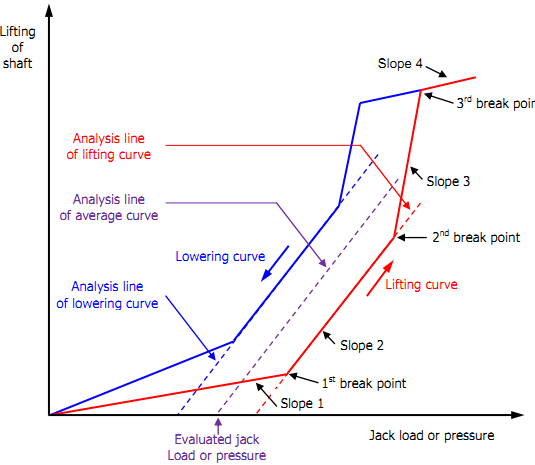|
|
 发表于 2015-6-18 13:04
|
显示全部楼层
发表于 2015-6-18 13:04
|
显示全部楼层
来自: 中国山东青岛
这个不是算法的问题,你首先要明白顶升曲线的含义。
请参考如下附件及内容,你就会明白关键问题不是选点了。
Initially all static load is in the bearing and no load is in the jack. By progressive increase
of jack load, the static load of the bearing is progressively transferred to the jack. The
slope 1 is rising moderately (low gradient). The bearing follows the lift of the shaft, i.e.
there is no bottom clearance and thus no reduction of top clearance.
1st break point:
The transfer of static load from bearing to jack is completed.
The measured lift of shaft is related to bearing support stiffness and bearing load.
Slope 2:
This part of the plotted jack-up test results is required for evaluation of the bearing load. It
needs to be long enough to allow a clear determination of the analyse line direction.
Thus it needs to contain quite a number of readings which show the same increase of jack load
“ΔFjack” resulting in the same increase of lift “Δhjournal”, i.e. the same ratio of “ΔFjack / Δhjournal”.
The further increase of jack load progressively transfers static load from the 2nd next
bearing to the jack. Due to a larger distance (lever) between 2nd next bearing and jack, the
slope 2 is rising more steeply (larger gradient).
The bearing next to the jack is not in contact with the journal anymore. Thus its bottom
clearance increases and its top clearance reduces.
2nd break point:
The transfer of static load also from the 2nd next bearing to the jack is completed.
Slope 3:
The further increase of jack load progressively transfers static load from the 3rd next
bearing to the jack. Due to an even more larger distance (lever) between 3rd next
bearing and jack, the slope 3 is rising even more steeply (largest gradient).
3rd break point:
The shaft touches the upper shell of a bearing.
Slope 4:
The further increase of jack load “ΔFjack” results in a significantly reduced lift of shaft
“Δhjournal” (if any), i.e. in a much lower gradient of slope 4 for the curve of plotted jack-up
test results.
|
-

|